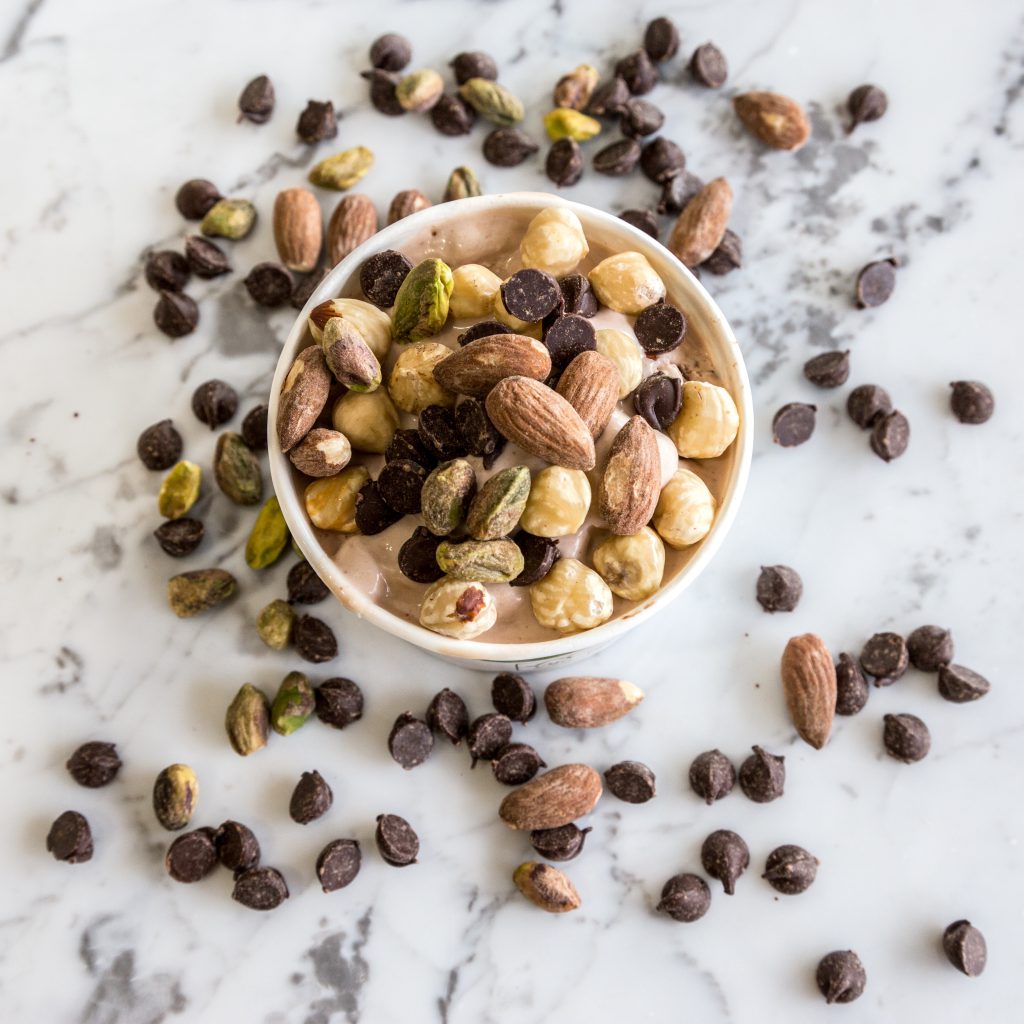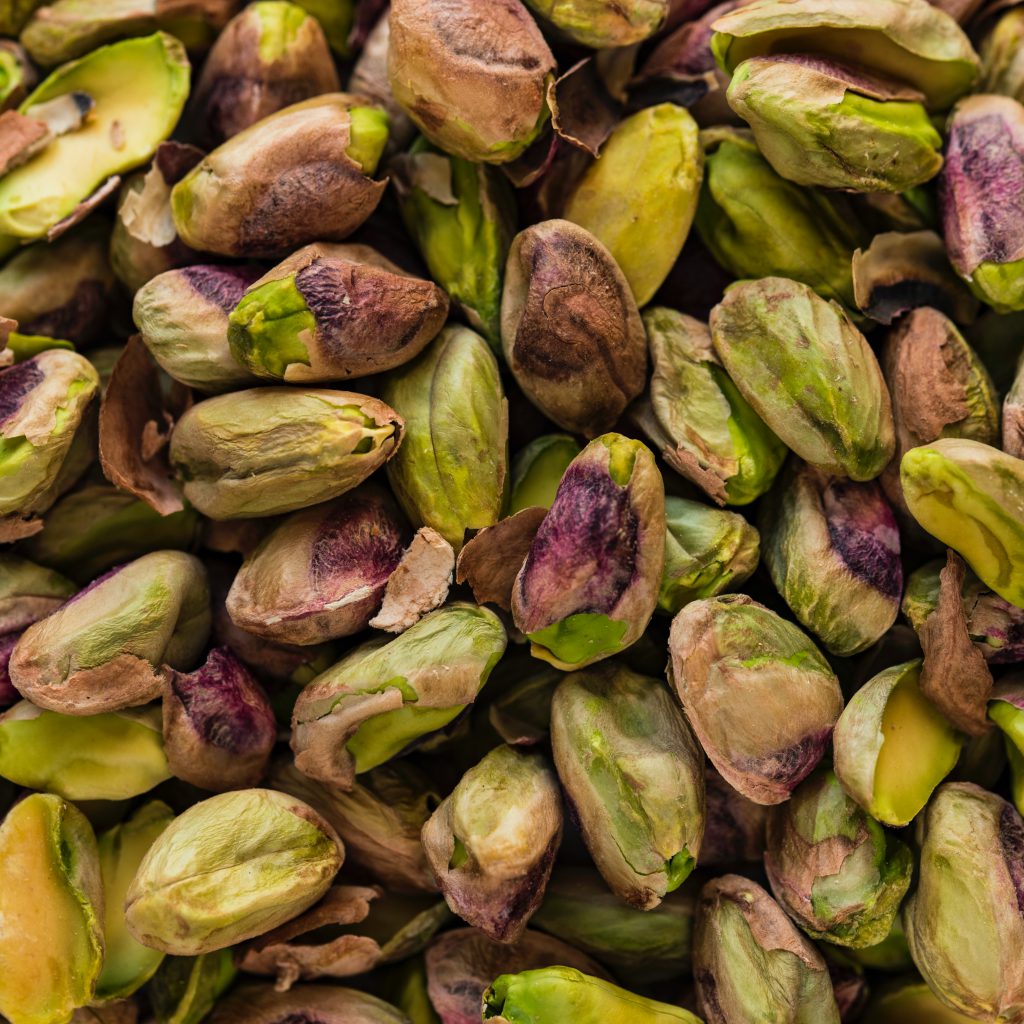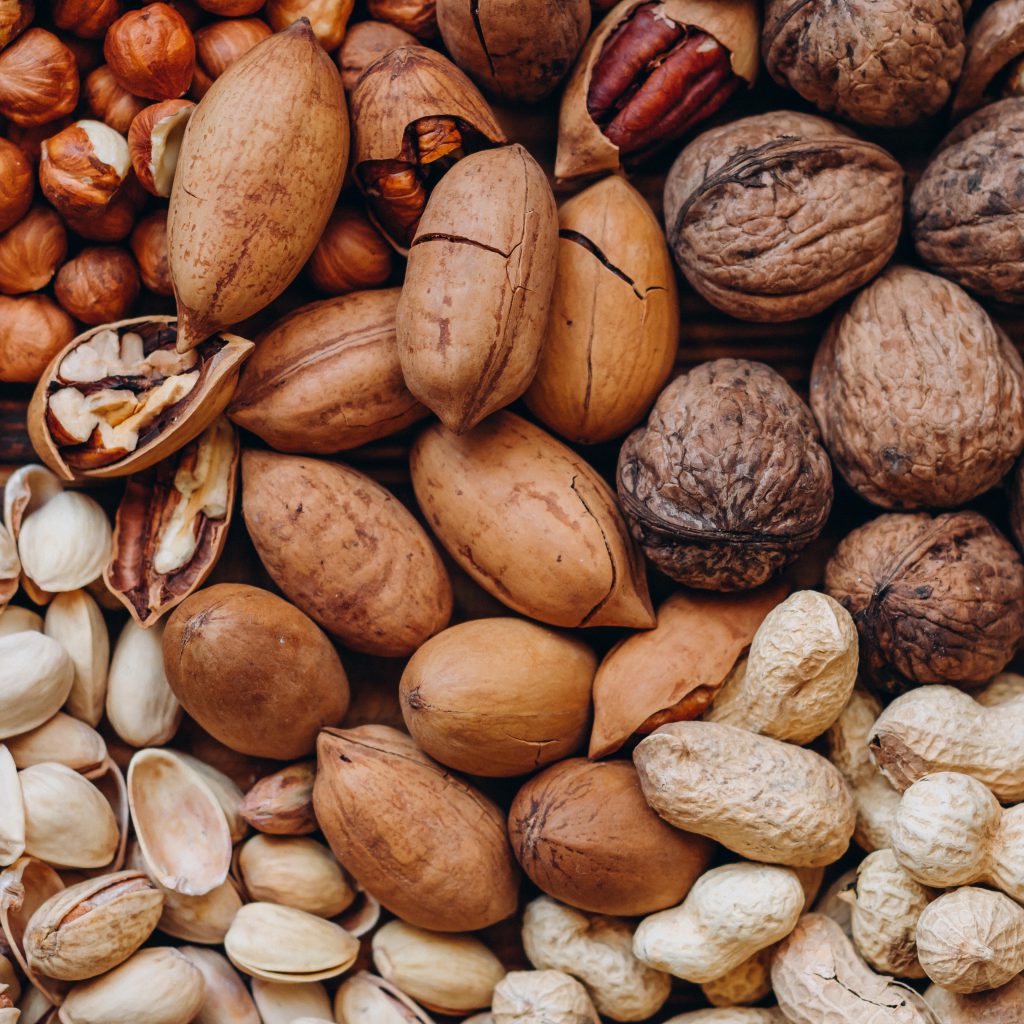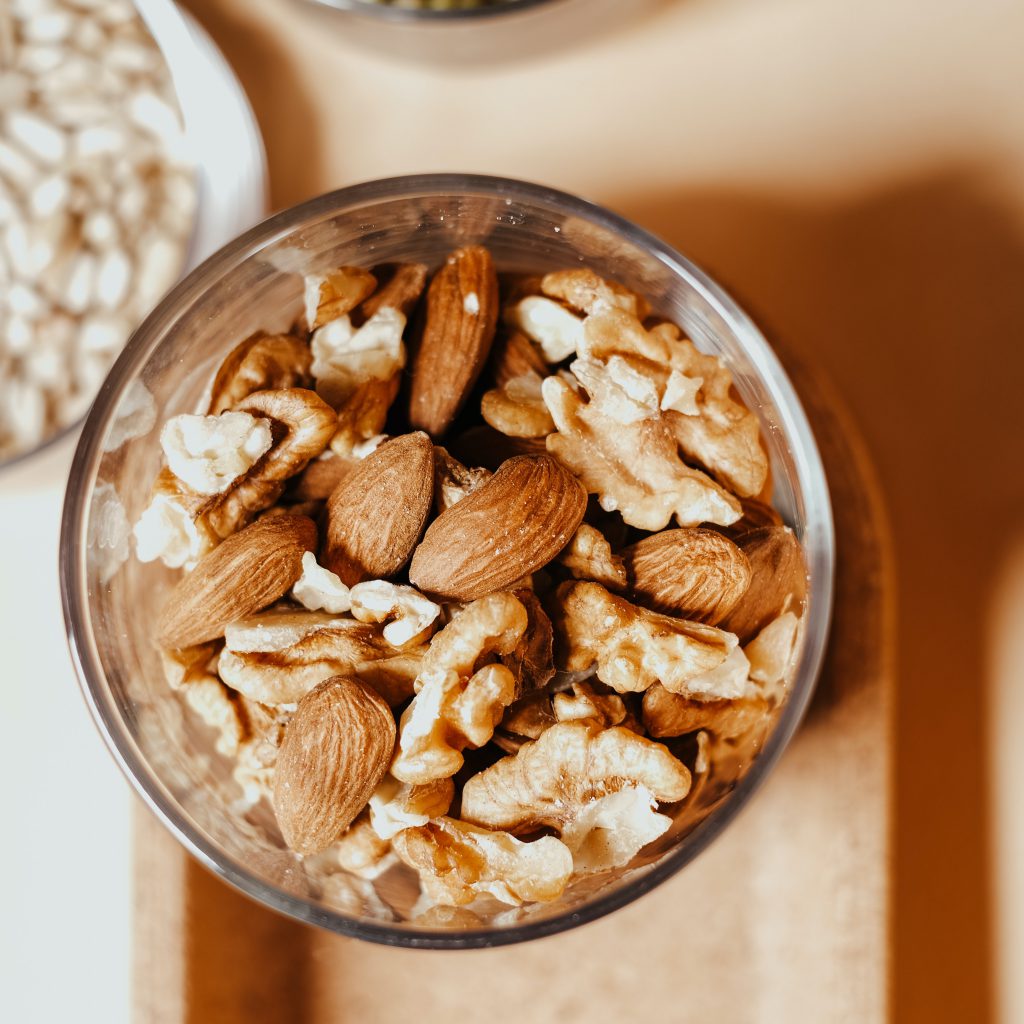Last Updated on October 27, 2023
Small yet powerful, nuts are packed with countless health benefits and can be great additions to any meal. If you know how to make good use of different nuts, you can turn a regular dish into a creamy wonder with delicious earthy notes.
Read on to discover how to incorporate nuts to elevate your dishes.
What Exactly Are Nuts?

It’s almost explicit what we mean when we say nuts. Walnuts, almonds, pistachios, hazelnuts, cashews… You know the gang. But in reality, not all of them are, well, nuts.
The definition of what makes for a true nut goes back to the formation of the flower. Without getting into complex details, hazelnuts, chestnuts, Brazil nuts, and acorns are all considered real nuts.
On the other hand, cashews, pistachios, and almonds are called drupes in botany, i.e., fruits covered in a single hard shell, just like coconuts, plums, peaches, and apricots. And what we consume when we eat these not-nuts is their seeds. Fun fact: Apricot seeds are also quite delicious, but it’s not advised to eat more than 1 or 2 per day due to their toxicity.
On the other hand, peanuts are actually legumes. Like lentils and soybeans, peanuts are edible seeds that grow in pods.
And some members of the nut squad don’t fit in any of these groups. For instance, walnuts and pecans are somewhere between nuts and drupes — some refer to them as drupaceous nuts.
So what is the meaning of all these? We, humans, like to classify things, but sometimes nature comes off in quite complex ways, bewildering biologists and common folk. The fact that most of the nuts you knew as nuts actually aren’t anything of sorts doesn’t mean you should treat them differently. Nuts will be nuts and will keep reappearing from under the sofa weeks after you serve them at a gathering.
However, the next time you get a pack of assorted nuts to snack on, know that you’re getting a pack of fruit seeds, legumes, and nuts. Even though they look similar in terms of physical and chemical properties, they have different effects on your health.
How Healthy Are Nuts?

Every nut has different nutritional credentials. Naturally, some of them are richer in some specific nutrients than others. But in general, they are all very high in fats that are impeccable for our bodies.
Healthy Fats

Seeds and nuts are very high in fats as they store them as an energy source. Although most legumes use carbohydrates for that, peanuts are closer to nuts in that regard, having a quite high-fat ratio.
That’s why you see different aromatic cooking oils made of all sorts of nuts, such as peanut, walnut, or hazelnut oils. This also makes nuts one of the main sources of omega-3 fatty acids, the superstars of the incredible health benefits of nuts.
Antioxidants

Most nuts contain polyphenols, a compound that works as an antioxidant. And the benefits of antioxidants are virtually countless, but in a nutshell, they support well-being by neutralizing unstable molecules, also known as free radicals, linked to cell decay.
Chestnuts are the richest in terms of polyphenols ratio. A gram of it contains around 13 milligrams of polyphenols. Hazelnuts and pecans follow that with around 6 milligrams per gram.
Fiber

Nuts are also a good source of fiber, which promotes well-being in various ways. It prevents heart and gastric diseases, promotes good gut bacteria, enhances immune function, and promotes weight loss in obese patients by improving insulin sensitivity.
Almonds, walnuts, pine nuts, and pistachios rank the highest in fiber ratio, followed by hazelnuts, pecans, peanuts, and macadamia nuts.
Vitamins and Minerals

Nuts also contain vitamins and minerals in abundance. They are all high in Vitamin E and different B-complex groups, as well as minerals like potassium, manganese, calcium, magnesium, iron, selenium, and zinc.
Because they all have different ratios of different nutrients, it’s a good idea to eat a mixture of assorted nuts daily to benefit from all of the good stuff they have to offer.
Can Nuts Help You Lose Weight?

Nuts contain a lot of fats, and even though they are tiny, they have high-calorie scores. This might persuade some people to avoid them, thinking they might be fattening.
Although they are indeed high in calories, you can’t really intake too many calories as long as you don’t overeat them. As a matter of fact, consuming nuts regularly is associated with weight loss, in conclusion to several different studies.
The exact reason why nuts help weight loss hasn’t been pinpointed yet. It’s probably because the fatty acids, antioxidants, fiber, and other compounds in nuts affect different systems throughout the body. However, we know that fiber is digested slowly, thus suppressing appetite. Plus, nuts are associated with triggering the production of certain hormones that regulate appetite.
In summary, nuts do contain high calories, and if you eat them immoderately, they might cause you to put on some weight. However, when you consume them in recommended amounts, they cancel out their extra calories by making you feel fuller for a longer time.
Are Nuts Safe for Everyone?

Nuts are beneficial for most of us, but they are also one of the most common allergens out there. The tiny, earthy, healthy bite-sized kernels can be very dangerous for people whose bodies react negatively to them.
Not to put you on alarm, but the fact that you don’t have a nut allergy doesn’t mean you won’t develop it as an adult. Although nut allergies are thought to present themselves in the early stages of life, a study from the Journal of Allergy and Clinical Immunology suggests nearly 1 in 5 peanut allergy patients in the US has developed it after the age of 18. So, if you suspect you have a nut allergy, you must consult your doctor immediately.
If you’re one of the crowds who can handle any nut with no problem, congratulations! However, cross-contamination is a source of concern for those around you who do have a nut allergy since even a trace amount of nuts can trigger a serious reaction. For that reason, it’s important to be fully informed about nut allergies in your close circle.
Apart from allergies, nuts can be hard to digest. As with any other food, overeating them can cause some side effects such as digestion issues, bloating, or diarrhea. Going overboard with them is also a quick way to put on some weight.
Lastly, because nuts are typically very potent, consuming a particular nut in excess can lead to some toxins accumulating in your body. So how much is okay for an adult? According to Australian Health Guidelines, 30g of assorted nuts most days — not every day — of the week is a good amount to benefit from their nutrition while protecting yourself from the potential risks.
What Kind of Nuts to Purchase

When you go to a nuttery — spread the word, it’s actually the name of a shop that specifically sells nuts — or the snacks section of the grocery store, you’ll see that you can get all sorts of nuts.
You can buy them with or without shells, raw, dry roasted, oil roasted, salted, or even seasoned. All these processes affect the nut’s taste, health benefits, storage conditions, and ultimately how to treat them when cooking with them.
Shelled vs. Unshelled

There’s no nutritional difference between shelled and unshelled nuts. However, when a nut is shelled, you can judge its quality better as the nut itself is visible. It’s important to purchase fresh nuts because they are richer in nutrients and naturally taste much better.
The omega-3 fatty acids present in the nuts are a type of unsaturated fatty acid, which means it’s volatile. Volatile fatty acids are prone to go under a chemical reaction when they are exposed to heat, light, or even air.
A shell is usually a great shield for a nut, protecting it against the common contaminants of the outer world: heat, light, moisture, and bacteria. That’s the reason why unshelled nuts have a longer shelf life. While every single nut type has a different shelf life, in general, nuts stay fresher for up to 6 months more when they are kept in their shells.
Another advantage of purchasing unshelled nuts is the price. They usually come in cheaper. Since some of the weight will be discarded after you remove the crusts, you might need to do a calculation to determine the cost-effectiveness of your purchase. However, as a rule of thumb, you can think they’ll lose half of the weight on average when you remove the shells. Still, when you get them unshelled, the price is usually less than half of the shelled ones.
Purchase Fresher and Cheaper

The advantages of getting your nuts in their natural shields are as follows:
- They have a longer shelf life
- They taste better as they stay fresher
- They are cheaper.
So buying nuts in bulk, for example, at the farmers market when they are in season, unshelled is the smartest way to go about it.
On the other hand, removing the shells yourself does require some effort. But you don’t have to go through all of them at once. You can do it every time you need a new fresh batch and store the unshelled nuts in a dry and cool place for up to a year. This way, you won’t spend a fortune on small packages of nuts, and you’ll never run out of fresh and flavorful nuts the whole year round.
As a side note: The nut shells are also great substances for compost.
Roasted vs. Unroasted

Just like roasting spices, roasting nuts enhances their flavor, makes them crunchy, and reveals different aroma notes that unroasted nuts lack. Roasting can also change the number of calories in nuts and alter their taste and nutrition profile significantly.
While raw nuts contain more nutrients, some people might have difficulties digesting them. Roasted nuts are much easier to digest and less likely to cause bloating or upset your stomach.
In general, heating fatty acids is never a good idea, as it may lead to the formation of trans fatty acids. For that very same reason, raw nuts contain more nutrients. Plus, roasting increases the caloric content in most of the nuts — except for pistachio. However, if the nuts are roasted at low temperatures, you can get away with minimum damage while still benefiting from their enhanced flavor.
According to the Winnipeg Regional Health Authority, roasting nuts at 120°C to 150°C for a longer period of time instead of roasting them quickly at higher temperatures results in much tastier nuts.
If you’re looking for a way to introduce healthy nuts into your diet, the best thing you can do is to get them raw. While raw nuts are much better for our bodies, you might want to enjoy some creamy, nutty, and even salty roasted nuts. When that happens, there’s no reason not to roast some yourself. This way, you know your nuts aren’t roasted at very high temperatures, and by roasting a small batch at a time, you don’t risk them going bad all at once.
How to Roast Nuts at Home

Roasting nuts instantly boosts their flavor thanks to the aromatic oils in them. However, again, thanks to the aromatic oils in them, they can burn quite quickly. For that reason, you need to monitor the process closely when roasting any sort of nuts. The best way to do it is in the oven, where you can control temperature finely as opposed to the stovetop.
The type of oven you use matters too. A convection oven will brown nuts much more quickly than a conventional oven. As we mentioned earlier, roasting the nuts for a longer time at low temperatures is much better than doing it the other way around. And some nuts, like cashews and pine nuts, brown more quickly than others.
Generally speaking, lighter, more tender nuts like walnuts, pecans, and pistachios take 6-8 minutes to reach a perfect roast. Denser ones like hazelnuts, almonds, and macadamias will take up to 10 minutes.
So when you’re roasting a batch of nuts, use a timer, but trust your nose too. Properly roasted nuts are fragrant with a roasty smell, never acidic or burnt. Lastly, regardless of the type of nut, give the baking tray a shake halfway through so that they can brown evenly.
And remember, roasted nuts don’t last long. Therefore, roast in batches so that your delicious nuts don’t develop a rancid taste sitting in the cupboard. Roasting a weekly supply is a good idea so that you never run out of freshly roasted earthy crunches to assort your dishes with.
How to Use Nuts in Cooking

When you think about it, nuts are a very common snack. Peanut butter might have been a mainstay in your lunchbox since you were a kid. Or you might be accustomed to having them in your granola or smoothie. However, there are many more things you can do with nuts and all kinds of ways to incorporate them into your cooking.
In fact, some cuisines, like Moroccan or Lebanese cuisine, have been using them in their staple dishes for a very long time. Let’s talk about how you can level up your texture and flavor game by incorporating these little superfoods into your dishes.
Chopped Nuts

Using chunky pieces of nuts is a great way to add texture to your dishes and pastes. Use a food processor on low speed, pulsing only a few times or the good ol’ mortar and pestle, or chop them carefully on your cutting board.
You can add some chopped nuts to your salad for some extra crunchiness and earthy notes. You can also top your salsas and pastes like hummus with an assortment of chopped nuts to enhance the texture and flavor. It goes without saying they always steal the show when added to brownies and cookies too.
If you’re going to use them in pasta sauces or stews, give the nuts a brief pan fry first if you haven’t roasted them already. When you simmer them in a sauce or broth, the nuts will swell, soaking up the flavors of the liquid.
Blended Nuts

Believe us when we say some chefs call this magic dust. Blend some freshly roasted nuts in a food processor or a mortar until they turn into a fine dust.
This dust makes a great breading seasoning to coat meat, chicken, vegetables, or even fish. Use the mixture to coat your pan-fries. You can also simply sprinkle it over your salads or mix it into your favorite spice blend.
Nut Butters

Nut butter is another way to make something delicious out of nuts. Contrary to what you might think, making your own nut butter is quite easy, so you definitely don’t have to buy them ready-made. It goes without saying that DIYed nut butter tastes so much better than the ones you get from the market — and are much more economical too.
To make a batch of nut butter, add some roasted nuts to your food processor. You can combine different types of nuts and seeds like sunflower seeds, pumpkin seeds, or even chia seeds if you like. Blend until the nuts turn into a creamy paste.
It takes some time, around 7 to 10 minutes, so don’t worry if it looks super dry in the process. Blending the nuts releases the natural oils from their cells, turning the blended nuts into a creamy wonder. You can make it even more creamy by adding some neutral oil. And if you can’t get enough of the nutty flavor, add some flavorful oil like sesame oil or peanut oil in there.
Don’t forget to season it with salt. Other optional seasonings are cacao powder, vanilla extract, honey, agave, maple syrup, or brown sugar. However, go easy on the latter ones. Add by tasting at every teaspoon, as they can easily dominate the other flavors in the butter.
And voila! You can slather your nut butter on top of freshly toasted bread or add them to your creamy pasta sauce, salad dressings, or stews.
Over and Out!
Despite their petit scale, nuts can play an outsized role in the kitchen. Suitable for most diets from vegan to keto, they are not only tasty but also convenient and nourishing.
Thanks to their phenomenal earthy flavor and creamy nature, nuts can be a great addition to any dish, either for garnishing dishes or elevating their overall flavor. We hope this article inspires you to incorporate more nuts in your meals.







